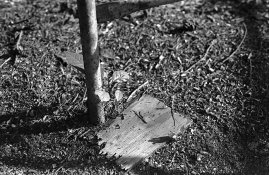I recently shot and processed my first roll of ADOX CMS 20, a new high resolution film (i.e. microfilm in a 35 mm cassette) apparently packaged for J&C Photo and/or Fotoimpex.
I'm impressed!
First, this stuff is about 25% cheaper than the Imagelink and Copex microfilms J&C sell in the same form. That's always good in my book. And though J&C offers their Adotech developer for it, they don't bundle it as Gigabit does, and as a result, again, don't push the pricing through the roof. Since I've been shooting microfilms in my subminiature cameras for a couple years, and processing them myself with good results, I wasn't afraid to handle this film with my own process, so I ordered five rolls and no developer.
I shot the first roll at EI 20, using the (recently repaired and calibrated) internal meter in my (recently serviced) Spotmatic SP. Aside from the first few shots on the roll, hoping a combination of very long lens, adequate exposure, and extremely fine film grain might allow me to get a usable image of Jupiter (well, it's big enough I'll probably try enlarging, but I don't see any detail in the planet when scanning -- less exposure next time, so much for inverse square law), I shot a number of high-detail subjects around my home. Processing was with my usual microfilm developer, Caffenol LC+C, with a guessed time, extrapolated from known times for fast and slow microfilms of other types, of 15 minutes, with continuous agitation for the first minute, then five inversions in 10 seconds every third minute.
Based on shadow detail and contrast, this looks like a very effective speed and time. As with most microfilm stocks, the base of this film is quite clear, though it appears the antihalation is adequate to avoid the necessity to load in the dark as is the case with some other clear-base 35 mm films. Unlike some rebranded films, this one has completely normal edge markings, with the brand information repeating on one edge, and frame numbers on the other, running from 1 to 37 with "A" half frame markings, though without the 0 and 00 frames I'm used to seeing on Kodak and Fuji films.
I haven't had a chance to print the negatives yet, but scanning at the highest resolution I have available, 2400 ppi, shows extremely smooth images, even at 1:1 crop, and sharpness that does an exceptional job of pointing up one of the limitations of hand held photography -- when shooting wide open, focused close, with a fast lens (Super Takumar 50 mm f/1.4), the depth of field is so shallow that unavoidable body movement while composing and the limitations of the eye and focusing screen will leave the focus off the intended plane more often than not -- not enough to be noticeable in most prints, but more than enough to show on screen at what amounts to 24x enlargement.
However -- the fact I can see this level of unsharpness at this resolution says much about the resolution of this film; even ISO 100 films I've used recently, Foma 100 (under various brandings), Neopan SS, and Delta 100, don't come near to recording detail smaller than a pixel at this resolution, but it appears CMS 20 can in fact do so, and with the right lens and sufficiently careful focusing, ought to be capable of duplicating the feats used to advertise other microfilm derived high res films.
I'm used to Caffenol LC+C delivering a significant speed increase over simpler low contrast developers on other microfilms, but the coupled offering of Adotech with CMS 20 suggests that the advertised speed is to be obtained with that optimized developer, so it's not surprising to see I gained no speed over the rating; I'd guess this film is similar speed to Imagelink HQ, which gives EI 12 in a POTA-like developer and EI 25 in a speed gaining developer like the one SPUR offers for it.
Future plans include attempting reversal processing, in hopes of getting up to EI 50 or 64, which (for the way I shoot) is a lot more usable film speed...
I'm impressed!
First, this stuff is about 25% cheaper than the Imagelink and Copex microfilms J&C sell in the same form. That's always good in my book. And though J&C offers their Adotech developer for it, they don't bundle it as Gigabit does, and as a result, again, don't push the pricing through the roof. Since I've been shooting microfilms in my subminiature cameras for a couple years, and processing them myself with good results, I wasn't afraid to handle this film with my own process, so I ordered five rolls and no developer.
I shot the first roll at EI 20, using the (recently repaired and calibrated) internal meter in my (recently serviced) Spotmatic SP. Aside from the first few shots on the roll, hoping a combination of very long lens, adequate exposure, and extremely fine film grain might allow me to get a usable image of Jupiter (well, it's big enough I'll probably try enlarging, but I don't see any detail in the planet when scanning -- less exposure next time, so much for inverse square law), I shot a number of high-detail subjects around my home. Processing was with my usual microfilm developer, Caffenol LC+C, with a guessed time, extrapolated from known times for fast and slow microfilms of other types, of 15 minutes, with continuous agitation for the first minute, then five inversions in 10 seconds every third minute.
Based on shadow detail and contrast, this looks like a very effective speed and time. As with most microfilm stocks, the base of this film is quite clear, though it appears the antihalation is adequate to avoid the necessity to load in the dark as is the case with some other clear-base 35 mm films. Unlike some rebranded films, this one has completely normal edge markings, with the brand information repeating on one edge, and frame numbers on the other, running from 1 to 37 with "A" half frame markings, though without the 0 and 00 frames I'm used to seeing on Kodak and Fuji films.
I haven't had a chance to print the negatives yet, but scanning at the highest resolution I have available, 2400 ppi, shows extremely smooth images, even at 1:1 crop, and sharpness that does an exceptional job of pointing up one of the limitations of hand held photography -- when shooting wide open, focused close, with a fast lens (Super Takumar 50 mm f/1.4), the depth of field is so shallow that unavoidable body movement while composing and the limitations of the eye and focusing screen will leave the focus off the intended plane more often than not -- not enough to be noticeable in most prints, but more than enough to show on screen at what amounts to 24x enlargement.
However -- the fact I can see this level of unsharpness at this resolution says much about the resolution of this film; even ISO 100 films I've used recently, Foma 100 (under various brandings), Neopan SS, and Delta 100, don't come near to recording detail smaller than a pixel at this resolution, but it appears CMS 20 can in fact do so, and with the right lens and sufficiently careful focusing, ought to be capable of duplicating the feats used to advertise other microfilm derived high res films.
I'm used to Caffenol LC+C delivering a significant speed increase over simpler low contrast developers on other microfilms, but the coupled offering of Adotech with CMS 20 suggests that the advertised speed is to be obtained with that optimized developer, so it's not surprising to see I gained no speed over the rating; I'd guess this film is similar speed to Imagelink HQ, which gives EI 12 in a POTA-like developer and EI 25 in a speed gaining developer like the one SPUR offers for it.
Future plans include attempting reversal processing, in hopes of getting up to EI 50 or 64, which (for the way I shoot) is a lot more usable film speed...
Attachments
Last edited by a moderator:





